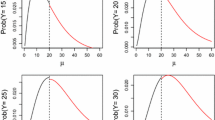Abstract
Generalized estimating equations have been widely used in the analysis of correlated count data. Solving these equations yields consistent parameter estimates while the variance of the estimates is obtained from a sandwich estimator, thereby ensuring that, even with misspecification of the so-called working correlation matrix, one can draw valid inferences on the marginal mean parameters. That they allow misspecification of the working correlation structure, though, implies a limitation of these equations should scientific interest also be in the covariance or correlation structure. We propose herein an extension of these estimating equations such that, by incorporating the bivariate Poisson distribution, the variance-covariance matrix of the response vector can be properly modelled, which would permit inference thereon. A sandwich estimator is used for the standard errors, ensuring sound inference on the parameters estimated. Two applications are presented.







Similar content being viewed by others
References
Agresti A (2002) Categorical data analysis, 2nd edn. Wiley, New York
Breslow N (1984) Extra-poisson variation in log-linear models. Applied Statistics 33:38–44
Breslow N, Clayton D (1993) Approximate inference in generalized linear mixed models. J Am Stat Assoc 88:9–25
Crowder M (1995) On the use of a working correlation matrix in using generalised linear models for repeated measures. Biometrika 82:407–410
Diggle P, Heagerty P, Liang K, Zeger S (2002) Analysis of longitudinal data, 2nd edn. Oxford Science Publications, Clarendon Press, Oxford
Fahrmeir L, Tutz G (1994) Multivariate statistical modelling based on generalized linear models. Springer, Heidelberg
Fahrmeir L, Tutz G (2001) Multivariate statistical modeling based on generalized linear models. Springer series in statistics, 2nd edn. Springer, New York
Fan J, Huang T, Li R (2007) Analysis of longitudinal data with semiparametric estimation of covariance function. J Am Stat Assoc 102(478):632–641. doi:10.1198/016214507000000095
Fitzmaurice G, Laird N, Ware J (2004) Applied longitudinal analysis. Wiley, New York
Hardin J, Hilbe J (2003) Generalized estimating equations. Chapman and Hall/CRC, Boca Raton
Iddi S, Molenberghs G (2013) A marginalized model for zero-inflated, overdispersed and correlated count data. Electron J Appl Stat Anal 6:149–165
Karlis D (2003) An em algorithm for multivariate poisson distribution and related models. J Appl Stat 30:63–77
Kassahun W, Neyens T, Molenberghs G, Faes C, Verbeke G (2012) Modeling overdispersed longitudinal binary data using a combined beta and normal random-effects model. Arch Public Health 70(1):1
Kim H, Shults J (2010) %qls SAS macro: a SAS macro for analysis of correlated data using quasi-least squares. J Stat Softw 35:1–22
Kocherlakota S, Kocherlakota K (1992) Bivariate discrete distributions. CRC Press, Boca Raton
Kocherlakota S, Kocherlakota K (2001) Regression in the bivariate poisson distribution. Commun Stat Theory Methods 30:815–825
Lakshminarayana J, Pandit S, Rao K (1999) On a bivariate poisson distribution. Commun Stat Theory Methods 28:267–276
Lambert D (1992) Zero-inflated poisson regression, with an application to defects in manufacturing. Technometrics 34:1–13
Lawless J (1987) Negative binomial and mixed poisson regression. Can J Stat 15:209–225
Lee Y, Nelder J (2004) Conditional and marginal models: another view. Stat Sci 19:219–228
Leng C, Zhang W, Pan J (2010) Semiparametric mean-covariance regression analysis for longitudinal data. J Am Stat Assoc 105(489):181–193. doi:10.1198/jasa.2009.tm08485
Leppik I, Dreifuss F, Bowman-Cloyd T et al (1985) A double-blind crossover evaluation of progabide in partial seizures. Neurology 35:285
Lesaffre E, Asefa M, Verbeke G (1999) Assessing the goodness-of-fit of the Laird and Ware model-an example: the Jimma infant survival differential longitudinal study. Stat Med 18:835–854
Liang K, Zeger S (1986) Longitudinal data analysis using generalized linear models. Biometrika 73:13–22
Liang K, Zeger S, Qaqish B (1992) Multivariate regression analyses for categorical data. J R Stat Soc B 54:3–40
Lindsey J, Lambert P (1998) On the appropriateness of marginal models for repeated measurements in clinical trials. Stat Med 17:447–469
Lipsitz S, Laird N, Harrington D (1991) Generalized estimating equations for correlated binary data: using the odds ratio as a measure of association. Biometrika 78:153–160
McCullagh P, Nelder J (1989) Generalized linear models. Chapman & Hall, London
Molenberghs G, Verbeke G (2005) Models for discrete longitudinal data. Springer, New York
Molenberghs G, Verbeke G, Demétrio C (2007) An extended random effects approach to modeling repeated overdispersed count data. Lifetime Data Anal 13:513–531
Molenberghs G, Verbeke G, Demétrio C, Vieira A (2010) A family of generalized linear models for repeated measures with normal and conjugate random effects. Stat Sci 25:325–347
Nelder J, Wedderburn R (1972) Generalized linear models. J R Stat Soc B 135:370–384
Prentice R (1988) Correlated binary regression with covariates specific to each binary observation. Biometrics 44:1033–1048
Prentice R, Zhao L (1991) Estimating equations for parameters in means and covariances of multivariate discrete and continuous response. Biometrics 47:825–839
Ridout M, Hinde J, Demetrio C (2001) A score test for a zero-inflated poisson regression model against zero-inflated negative binomial alternatives. Biometrics 57:219–233
Solis-Trapala I, Farewell V (2005) Regression analysis of overdispersed correlated count data with subject specific covariates. Stat Med 24:2557–2575
Sun W, Shults J, Leonard M (2009) A note on the use of unbiased estimating equations to estimate correlation in analysis of longitudinal trials. Biom J 51:5–18
Thall P, Vail S (1990) Some covariance models for longitudinal count data with overdispersion. Biometrics 46:657–671
Wang Y, Carey V (2004) Unbiased estimating equations from working correlation models for irregularly timed repeated measures. J Am Stat Assoc 99:845–852
Winkelmann R (2008) Econometric analysis of count data. Springer, Berlin
Wolfinger R, O’Connell M (1993) Generalized linear mixed models: a pseudo-likelihood approach. J Stat Comput Simul 48:233–243
Ye H, Pan J (2006) Modelling of covariance structures in generalized estimating equations for longitudinal data. Biometrika 93:927–941
Zhao L, Prentice R (1990) Correlated binary regression using a quadratic exponential model. Biometrika 77:642–648
Ziegler A (2011) Generalized estimating equations. Springer, New York
Author information
Authors and Affiliations
Corresponding author
Rights and permissions
About this article
Cite this article
Kalema, G., Molenberghs, G. & Kassahun, W. Second-order generalized estimating equations for correlated count data. Comput Stat 31, 749–770 (2016). https://doi.org/10.1007/s00180-015-0599-1
Received:
Accepted:
Published:
Issue Date:
DOI: https://doi.org/10.1007/s00180-015-0599-1




